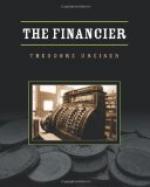“Not at all. I know the inside conditions there. The stock is bound to go up eventually. I’ll bull it up. I’ll combine it with my other lines, if necessary.”
Cowperwood stared at his boy. Never was there such a defiant, daring manipulator.
“You needn’t worry about me, father. If you are going to do that, call my loans. Other banks will loan on my stocks. I’d like to see your bank have the interest.”
So Cowperwood, Sr., was convinced. There was no gainsaying this argument. His bank was loaning Frank heavily, but not more so than any other. And as for the great blocks of stocks he was carrying in his son’s companies, he was to be told when to get out should that prove necessary. Frank’s brothers were being aided in the same way to make money on the side, and their interests were also now bound up indissolubly with his own.
With his growing financial opportunities, however, Cowperwood had also grown very liberal in what might be termed his standard of living. Certain young art dealers in Philadelphia, learning of his artistic inclinations and his growing wealth, had followed him up with suggestions as to furniture, tapestries, rugs, objects of art, and paintings—at first the American and later the foreign masters exclusively. His own and his father’s house had not been furnished fully in these matters, and there was that other house in North Tenth Street, which he desired to make beautiful. Aileen had always objected to the condition of her own home. Love of distinguished surroundings was a basic longing with her, though she had not the gift of interpreting her longings. But this place where they were secretly meeting must be beautiful. She was as keen for that as he was. So it became a veritable treasure-trove, more distinguished in furnishings than some of the rooms of his own home. He began to gather here some rare examples of altar cloths, rugs, and tapestries of the Middle Ages. He bought furniture after the Georgian theory—a combination of Chippendale, Sheraton, and Heppelwhite modified by the Italian Renaissance and the French Louis. He learned of handsome examples of porcelain, statuary, Greek vase forms, lovely collections of Japanese ivories and netsukes. Fletcher Gray, a partner in Cable & Gray, a local firm of importers of art objects, called on him in connection with a tapestry of the fourteenth century weaving. Gray was an enthusiast and almost instantly he conveyed some of his suppressed and yet fiery love of the beautiful to Cowperwood.
“There are fifty periods of one shade of blue porcelain alone, Mr. Cowperwood,” Gray informed him. “There are at least seven distinct schools or periods of rugs—Persian, Armenian, Arabian, Flemish, Modern Polish, Hungarian, and so on. If you ever went into that, it would be a distinguished thing to get a complete—I mean a representative—collection of some one period, or of all these periods. They are beautiful. I have seen some of them, others I’ve read about.”




